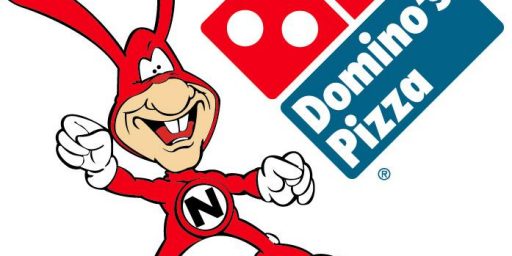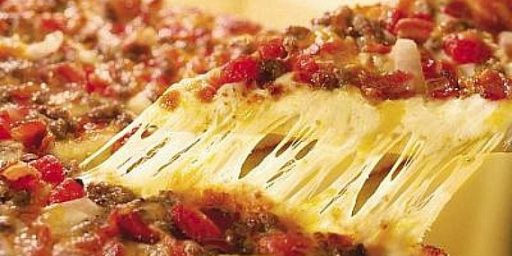DC Dominos Charging for Delivery
The Washington Post fronts its business section with word that local Domino’s Pizza stores will begin charging for delivery.
At Your Door? A Dollar More (E1)
Free pizza delivery may soon amount to pie in the sky. Next week, local Domino’s Pizza stores will begin charging a $1 delivery fee for any order. There’s no other way to slice the rising costs the chain has to pay for fuel, rent, insurance and food, especially cheese, the prices of which are “at record highs,” said David Carraway, president of Team Washington Inc., which owns 59 Domino’s stores in the Washington area. “Everything is going up. It’s not a decision we’re happy with, but it’s the reality of what we’re dealing with,” Carraway said. He added that some rivals are already charging the fee. “I wouldn’t be surprised if our competitors are not all doing it shortly.”
Pizza Hut spokeswoman Patty Sullivan said Washington area stores have been charging a delivery fee, averaging about 75 cents, for a few years. Local Papa John’s stores are not. However, some of the franchises in other areas are imposing a $1 to $1.50 delivery fee. “If high fuel prices continue, more markets, including Washington, might consider it,” said Papa John’s spokesman Chris Sternberg.
Nationwide, about 45 percent of all Domino’s stores charge a delivery fee, according to company spokeswoman Holly Ryan.
Why the price of cheese should affect delivery prices is unclear. Is the cheese used on the pizzas customers pick up or eat in the restaurant cheaper?
This is part of a larger trend of businesses advertising artificially low prices for goods and then adding on exorbitant fees. The most obvious example is the “handling” charge added to most mail order and Internet purchases, despite the rather obvious fact that handling merchandise is not a service but rather a cost of doing business. The other aggregious offenders are cell phone and cable television providers, which add semi-official looking “fees” for things like “federal regulatory cost recovery” or “landline connectivity.” One wonders why such things aren’t covered by truth in advertising laws.






How about tip jars for carry-out? I know it’s not quite the same because it’s technically voluntary, but it’s a pressure tactic at least. I don’t think I should have to tip for having my food handed to me in a styrophome container.
I can see the delivery charge simply because of the extra service involved. It’s routine around here for a buck, in rare instances 2, to be added, or certainly for there to be a minimum order size. My favorite sub & pizza shop, a family owned place near my office, has a $7.50 minimum, which if I just wanted a sub meant ordering fries or a salad too, or picking it up myself (delivery was mostly a convenience to not interrupt work flow).
The mention of cheese is bizarre. So? That goes into the food cost for everyone.
A lot has to depend on the arrangement with the delivery drivers. Are they tips only? Tips and a stipend for gas? Tips and a low wage? The buck would help cover paying the driver in two of those cases, and in turn that helps make up for crappy tippers.
I once worked as a delivery driver for a KFC in Fairbanks. We earned better than minimum wage and we received tips. We drove our own vehicles though, and I don’t remember getting a mileage or wear-and-tear reimbusement separate other compensation. Delivery customers did pay a $1 delivery charge, which helped offset paying the delivery drivers.
Courier jobs did pay separate mileage or wear-and-tear, but we didn’t get tips…
Mail-order companies added fees for “handling” long before there was an Internet. It gives the customer an incentive to submit a few large orders rather than many small ones. This obviously benefits the mail-order firm. But it also benefits the customers, because it really does reduce transaction costs.
This is not to say that all fees are rational, of course. I’m happy to tip someone that actually spends some time serving me, but I despise the tip jar. It completely misses the point.
I despised the fee they used to tack on my phone bill in Pasadena whose stated purpose was to help provide phone service to low-income households. Unfortunately, I think this was really was official.
It wasn’t until I started ordering pizzas from Pizza Hut online, where the whole bill is enumerated, that I noticed that they include a 75¢ Delivery Charge. I have no idea how long I’ve been paying that under the traditional system of calling on the phone and paying with cash.
I work at dominos. We have had a $1 fee for a number of months, but last week it jumped to $1.25.
The drivers here, get 4.15 (min wage here is 5.15) + tips. The money goes back to the store not the drivers.